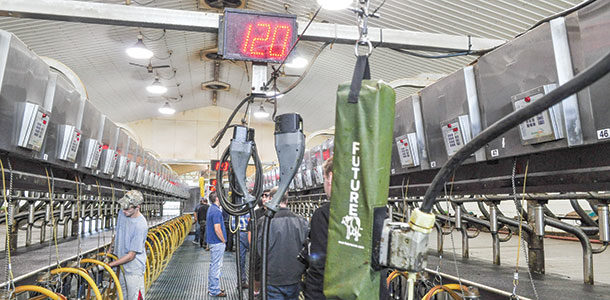When talking to Brett Feldpausch, manager and partner of his family’s dairy farms, Rich-Ro Dairy Farms in central Michigan, you can tell he takes his job seriously. “We have good employees, but we want to make sure they have the tools to do their jobs well,” Feldpausch says. That is why he installed his version of a parlor timer.
Throughout the U.S., there are parlor timers sprinkled here and there, but not many work in the same manner as the ones on Rich-Ro Farms.
“We wanted to help the consistency and routine for our employees. Each person is a little different in their procedure. We got the timer to take away another variable,” Feldpausch says.
Often, parlor timers are used to time how long a parlor turn takes. The idea is that it will help the employees make more turns an hour or at least four turns an hour. This is good if a dairy producer wants to maximize the use of a parlor. If they want to maximize on milk output and letdown, this might not be the ideal tool.
The Feldpausch timer works differently. When an employee begins prepping the first cow on a side, they hit the timer. It begins counting up. The employees are trained that when the timer hits 90 seconds, they can come back to that first cow and begin attaching the units.
They are also trained that they need to be back to that first cow before the timer hits 120 seconds. The farm is eliminating the inconsistency of attachment times by making sure the cows are attached in a 30-second window.
Consultant Tom Wall, also known as the Dairy Coach, says these kind of parlor timers make the milkers aware of each cow’s milk letdown time. Wall also says, “Before installing [parlor timers], managers need to do the work of making the parlor itself more efficient and then teach their milking team how time fits in the overall context of the milking process.
Most milkers already believe the most important result they need to achieve in the parlor is finishing the milking on time. They believe this because they’ve seen and heard how everyone (their boss, co-workers and even themselves) reacts when someone doesn’t get all the cows milked.”
Wall says dairy producers cannot forget that the goal in the parlor is much more complex than just getting the milking done by a certain time. The real goal is to “get all the cows milked correctly, consistently, completely and safely without causing any damage to the cows in order to ship high-quality milk.”
The management team on Rich-Ro Farms feels they are taking out discrepancies in the parlor. By minimizing the opportunity for failure, they are helping reduce the stress of their employees and ensuring they are doing a good job each milking shift. Their employees are not wondering constantly whether they are going at the right speed; they know they are going at the right speed if they are following the timer.
The management team is giving employees every chance to succeed. The Feldpausch family installed cameras in the parlor and check them regularly. With the ability to keep about 20 days’ worth of records, if employees are not following the timer, the Feldpausches will catch it and make sure the situation is dealt with correctly.
Wall wants all dairy producers to remember that just because the timer is working for some farms like the Feldpausches, there are several points that should be remembered and possibly met before taking the parlor timer plunge. Dairy managers need to audit the functionality and flow of their parlor in order to see how time is being used and how time use can be improved.
- Organize and locate all the parlor tools so they’re always in the right spot at the right time and anyone can use them.
- Make sure there are the correct number of people in the parlor who are also willing and able to do the work.
- Train each milker to follow a simple, strict routine and follow up to make sure they’re always doing it.
“Cows are easy to manage, but the people are hard,” Feldpausch says. The “teat timer,” as he calls it, has been a great tool for the farms. Since installing it, he has not had to replace a broken piece on the timer because he found a product that works. The Feldpausches have also seen their cows’ behavior change since using the timers.
Feldpausch says in the last four years since they started using the timers, the cows have calmed down. He believes it is due to the parlor consistency the timers offer, along with other parlor innovations they have implemented.
The farm also uses GEA’s FutureCow Prep System. Combine the prep system that allows different people to dip and strip the cows almost identically and the timer that makes sure attachment time is constant each milking, and the results are in the cows. PD
Ashley Messing-Kennedy is a freelance writer and dairy producer in Bad Axe, Michigan.
Photos courtesy of Ashley Messing-Kennedy.

Ashley Messing-Kennedy
Dairy Producer
Bad Axe, Michigan






